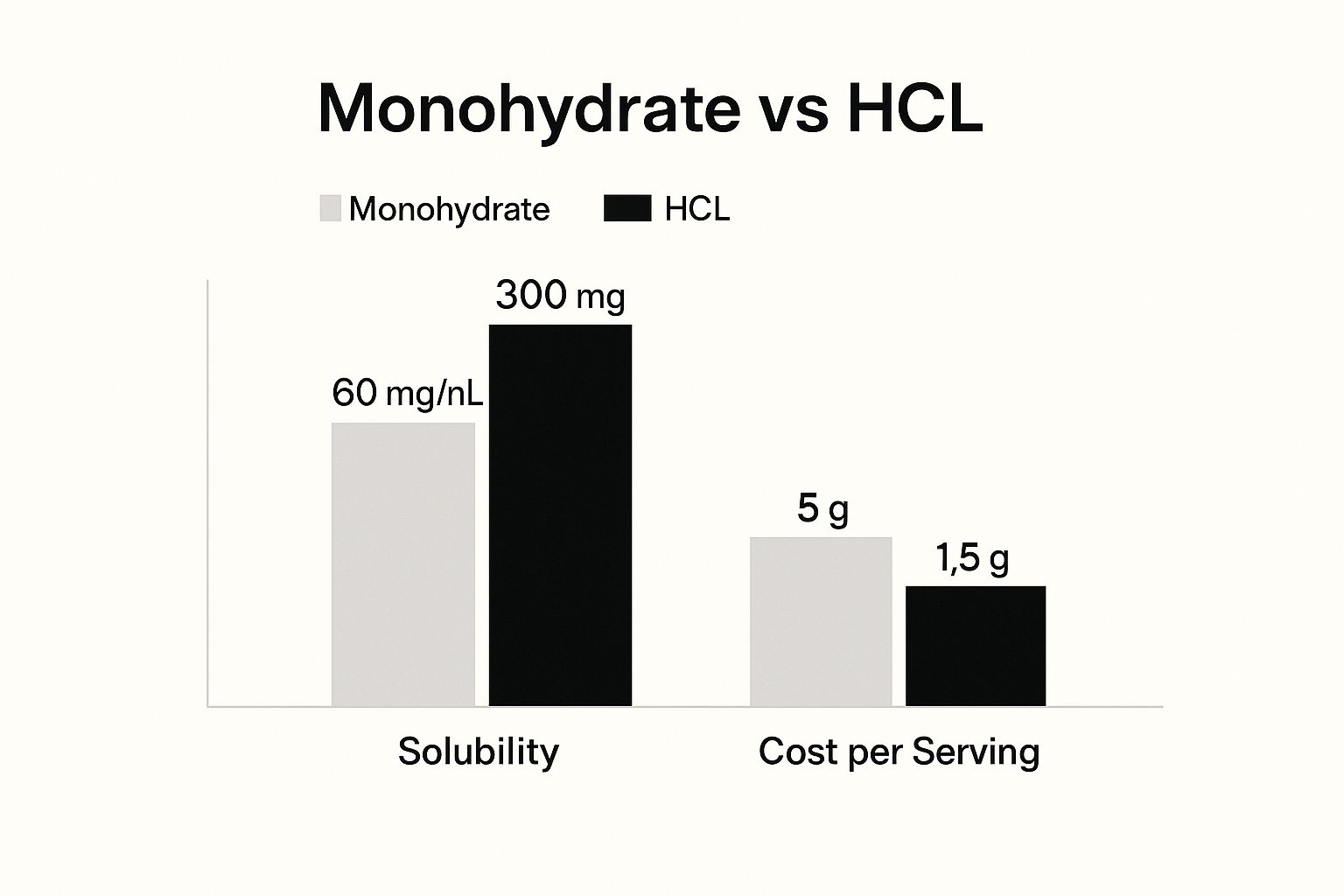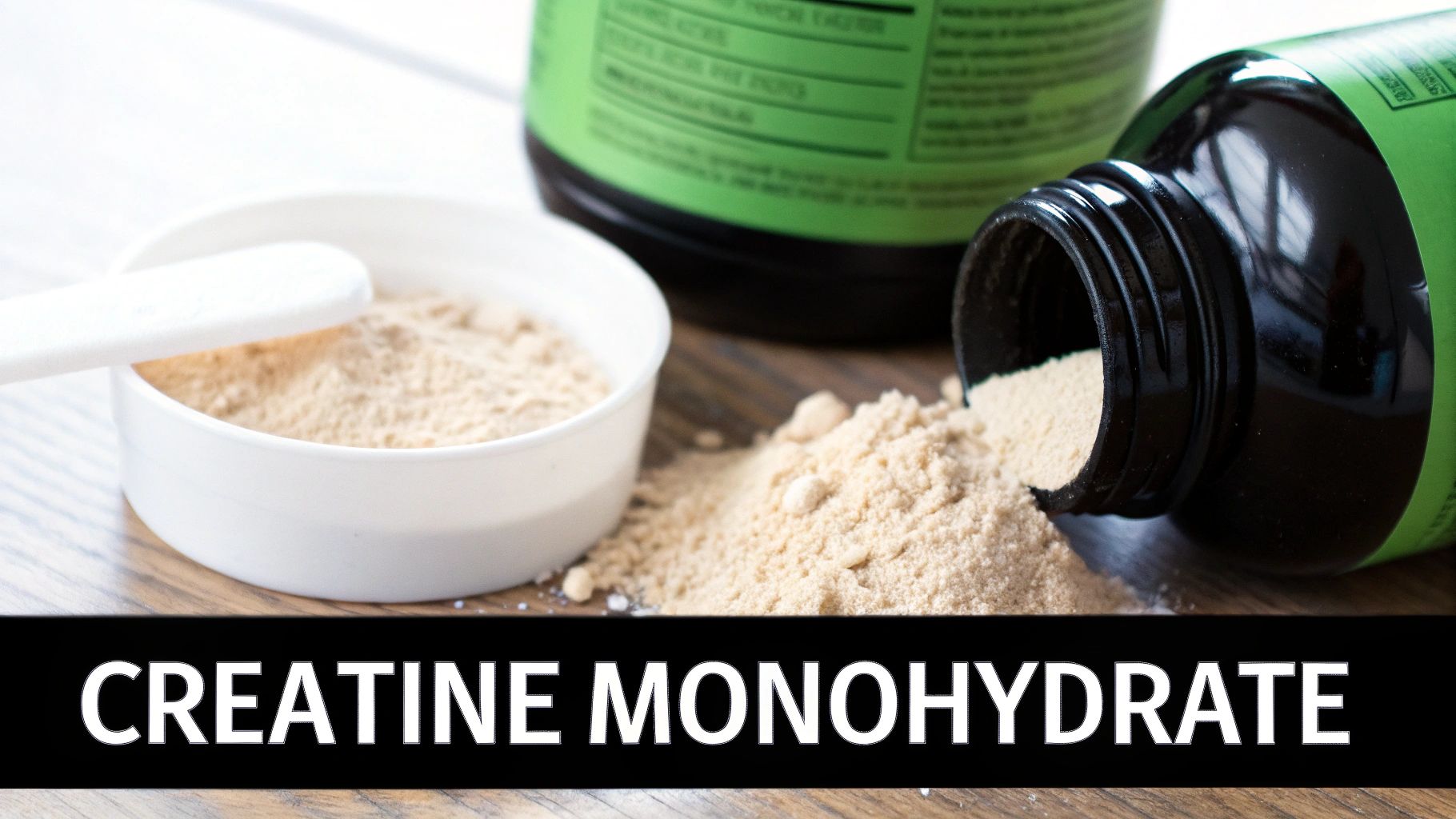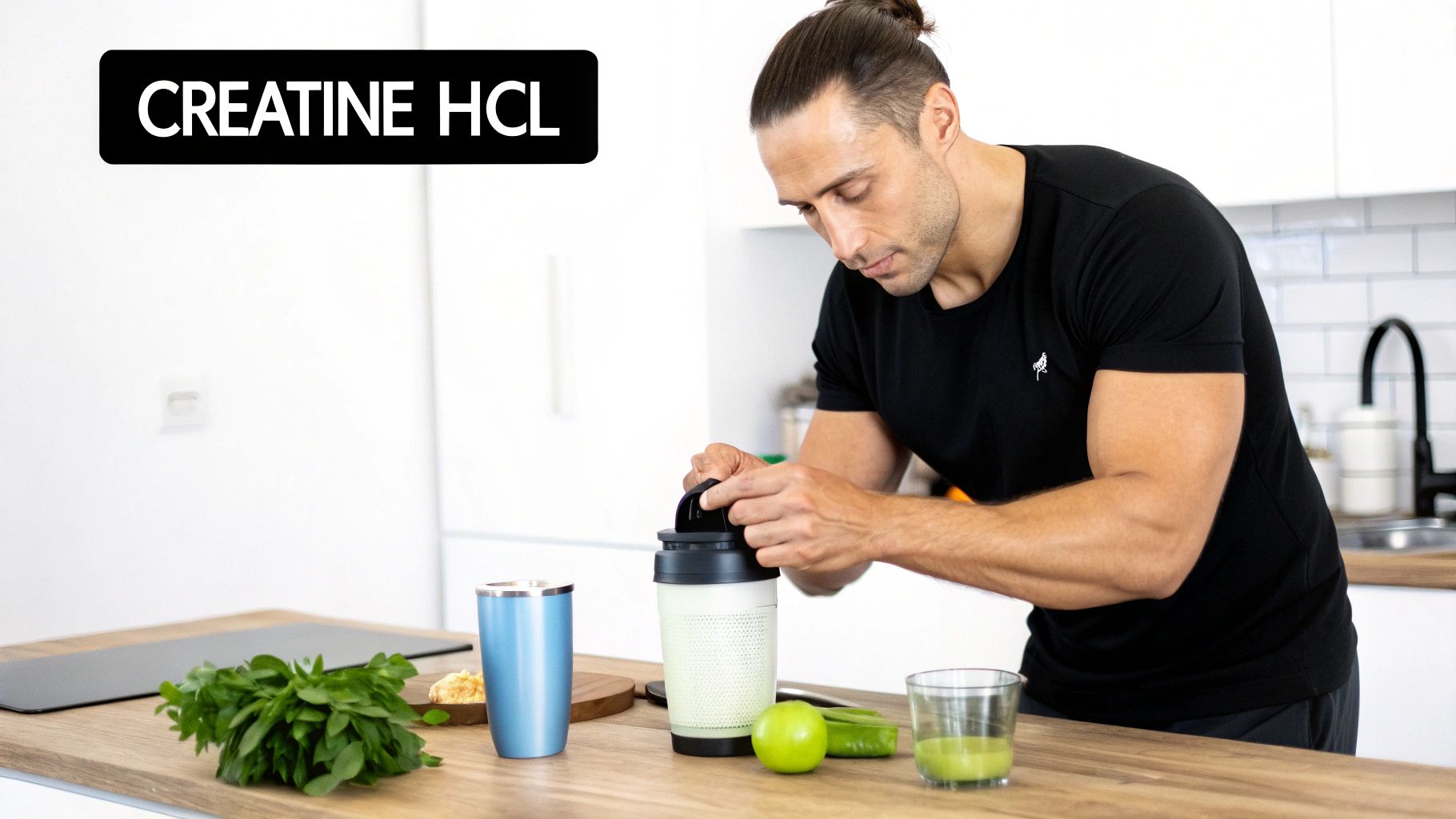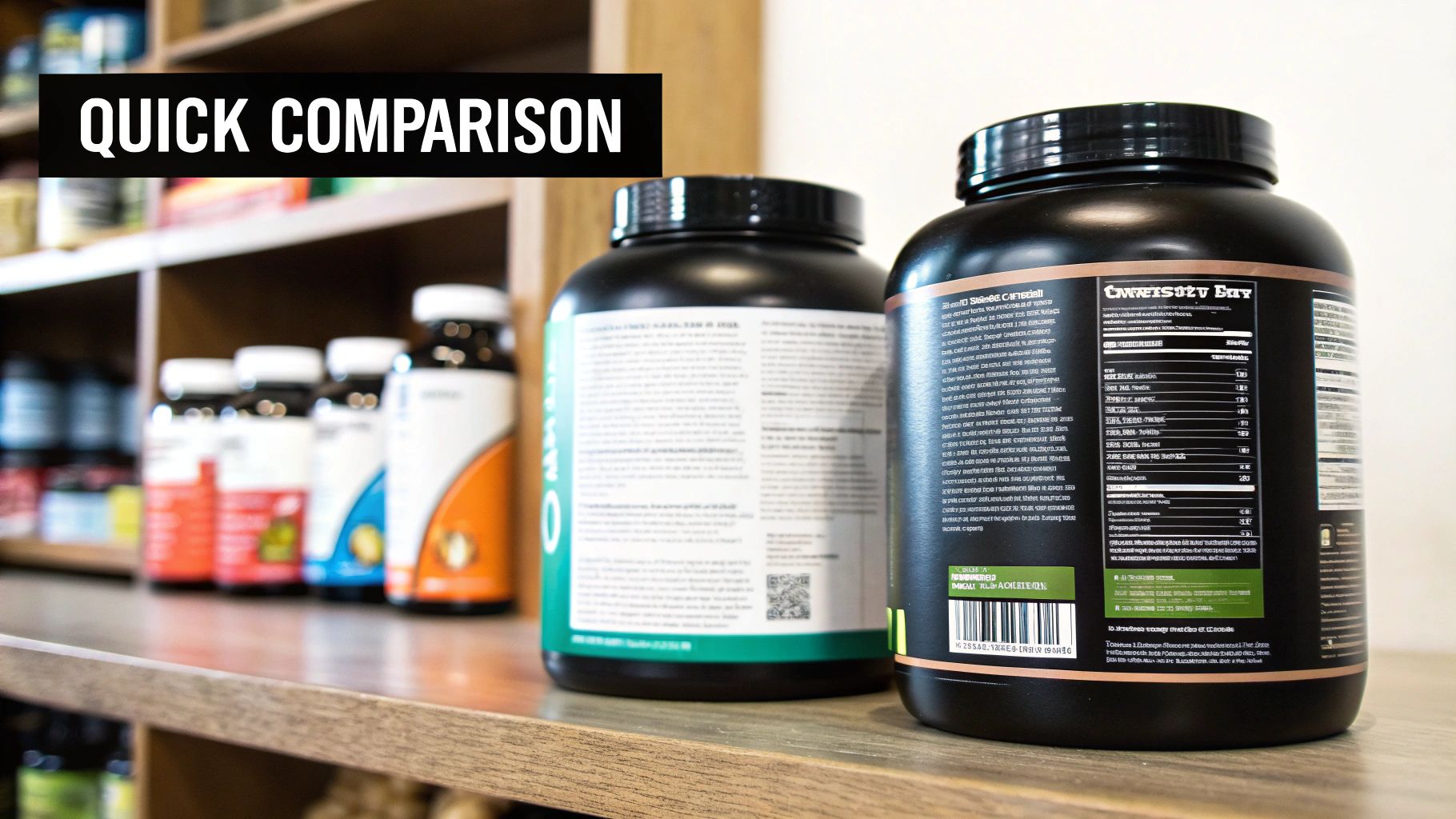
Creatine Monohydrate vs HCl The Ultimate Guide
Share
When you're standing in the supplement aisle, the creatine monohydrate vs. HCl debate can feel a bit overwhelming. But it really just comes down to a simple trade-off.
On one hand, you have creatine monohydrate—the undisputed, heavily researched gold standard. It's been proven effective for decades and is incredibly cost-effective. On the other, you have creatine HCl, a newer kid on the block engineered for better solubility, which might mean fewer digestive issues like bloating for some people.
Your choice really hinges on what you value more: proven performance and a friendly price tag, or enhanced mixability and gut comfort.
A Head to Head Comparison
Choosing the right creatine shouldn’t be a complex puzzle. Both forms are designed to do the same thing: saturate your muscles with creatine to boost strength and performance. The way they get there, however, is slightly different due to their chemical makeup.
Getting a handle on these core differences is the key to picking the supplement that best fits your goals, digestive system, and wallet. Let's break down the practical factors that actually matter when you're using it day-to-day.
Monohydrate vs HCl: The Core Differences
To make things simple, here’s a quick summary of how these two popular forms of creatine stack up against each other.
Quick Comparison: Monohydrate vs HCl
| Feature | Creatine Monohydrate | Creatine HCl |
|---|---|---|
| Scientific Backing | The most studied sports supplement on the planet, bar none. | Much less research, though what exists is promising. |
| Solubility in Water | Lower solubility. Can leave a gritty residue if you don't mix it well. | Way more soluble. It dissolves easily and leaves no grit behind. |
| Typical Daily Dose | The standard effective dose is 3-5 grams per day. | Marketed at 1-2 grams per day, thanks to claims of better absorption. |
| Common Side Effects | Can cause bloating or minor stomach upset in sensitive individuals. | Often chosen by people who want to avoid those specific digestive issues. |
| Cost Per Serving | Very affordable and easy to find everywhere. | Definitely more expensive per serving than its monohydrate cousin. |
The main difference is all about how well it dissolves.
Creatine HCl is bonded to a hydrochloride molecule, which makes it dissolve in water much more easily. This is the whole reason behind its smaller dose and why it's less likely to cause stomach issues.
This visual breakdown really highlights the practical differences in solubility, dosage, and cost between the two.

As you can see, HCl offers some serious advantages in how well it mixes and how little you need to take. But that convenience definitely comes at a higher price compared to the tried-and-true monohydrate.
Why Monohydrate Remains the Gold Standard

When you line up creatine monohydrate against HCl, the sheer weight of the evidence for monohydrate is hard to ignore. For decades, it’s been the foundation of sports nutrition, earning its title as the undisputed "gold standard." This isn't just clever marketing—it's a reputation built on hundreds of scientific studies.
The research overwhelmingly confirms its ability to boost strength, increase power, and help build lean muscle. Athletes and scientists trust it for one simple reason: it delivers results, time and time again. Its simple, stable structure means you're getting a pure product, and it's the very benchmark every new form of creatine has to measure up to.
A Legacy of Proven Performance
Creatine monohydrate's reliability is rooted in its long history in clinical trials. Newer forms of creatine are still playing catch-up, trying to build their research portfolio, but monohydrate has already been put through its paces for safety and effectiveness across all kinds of people.
The scientific consensus is clear: creatine monohydrate works. Its power to saturate muscle cells and fuel ATP for explosive energy is backed by a level of validation no other form can currently touch.
This is a huge part of why everyone, from seasoned pros to people just starting out, keeps coming back to it. You know exactly what you’re getting—a supplement with a proven track record for enhancing performance, no guesswork involved.
Unmatched Value and Accessibility
Beyond being effective, one of creatine monohydrate’s biggest advantages is its price. It’s incredibly cost-effective. Thanks to efficient production, it has become one of the most affordable and widely available performance supplements out there.
This accessibility means anyone can add it to their routine without a second thought, from weekend warriors to professional athletes. It’s expected to grow into a market worth around USD 520.46 million by 2032, driven by its proven benefits and low cost. Its universal acceptance has cemented its place as the top choice for consumers globally.
Ultimately, it’s the combination of solid scientific backing, high purity, and fantastic value that makes monohydrate so hard to beat. If you want to get even more specific, check out our guide on monohydrate vs. micronized creatine. This legacy of trust is why, even with all the new options available, monohydrate still reigns supreme.
So, What's the Deal with Creatine HCl?
While creatine monohydrate is the OG, creatine hydrochloride (HCl) is the newer, more refined player on the block. It was basically created to solve the few annoying issues people sometimes have with monohydrate. The big difference is its chemical structure—by attaching a hydrochloride molecule to creatine, its solubility in water goes through the roof.
And this isn't just some lab-nerd detail. It makes a real difference.
If you’ve ever swirled a gritty, clumpy monohydrate powder in your shaker bottle, you know what I’m talking about. HCl, on the other hand, dissolves almost instantly. This slick mixability is also why it's often linked with less bloating and stomach discomfort, making it a go-to for anyone with a sensitive gut.
Better Solubility Means a Better Experience
The entire case for creatine HCl really boils down to solving one major problem. That hydrochloride group makes the creatine molecule more acidic, which lets it dissolve way more easily in liquid.
The secret sauce of creatine HCl is its solubility. That’s why you’ll see it marketed as a more “advanced” option—the theory is you can take a smaller dose for the same effect and sidestep those gnarly stomach issues.
This makes it a really compelling choice for anyone looking for a smoother supplement routine, without the common gripes of monohydrate. It's built for those who don't mind spending a bit more for comfort and convenience.
This focus on a better user experience is exactly why HCl is gaining so much ground. In fact, it's an up-and-coming form of creatine that's expected to blow up. Projections show it growing at a CAGR of 26.5% between 2025 and 2030 in the U.S. alone, thanks to these practical perks. You can review the market projections and see for yourself why it's getting so popular.
Who Should Actually Use Creatine HCl?
Look, creatine HCl isn't "better" across the board, but it’s definitely the smarter pick in certain situations. It’s perfect for people who’ve felt bloated from monohydrate and want something that’s easier on their stomach.
Think about it—HCl is the obvious choice if you fit into one of these camps:
- You Have a Sensitive Stomach: If monohydrate left you feeling bloated or uncomfortable, HCl’s easy-to-dissolve nature could be a game-changer.
- You Just Want It to Be Easy: For those who hate shaking a gritty drink for five minutes, HCl mixes in seconds with no leftover clumps.
- You Prefer Smaller Doses: The typical 1-2 gram serving size is a nice perk for anyone who doesn't want to down a big scoop of powder every day.
When it comes down to the creatine monohydrate vs HCl debate, picking HCl is all about your personal priorities. It’s a precision tool for someone who values mixability and digestive comfort enough to pay a small premium for it.
Comparing Performance Efficacy and Absorption

When you pit creatine monohydrate against HCl, the conversation always seems to land on two things: absorption and real-world results. The marketing for creatine HCl loves to shout about its superior water solubility, but we need to look past the label. Does dissolving better in your shaker cup actually mean it performs better in the gym?
It's not that simple. Solubility is just about how well something mixes in a liquid. What we really care about is bioavailability—how much of that creatine actually gets into your bloodstream and makes it to your muscles. And that’s where the story gets interesting.
Monohydrate: The Gold Standard for a Reason
Creatine monohydrate has been the king for decades, and it's set an incredibly high bar for absorption. Study after study confirms that our bodies are unbelievably good at absorbing it. We're talking a bioavailability of over 99%. That means virtually every bit you take gets put to work.
With numbers like that, there's not much room for improvement. HCl proponents argue that its unique structure—a creatine molecule bonded to a hydrochloride—makes it even better, but the hard evidence from human trials showing it saturates muscles more effectively just isn't there yet. In a way, HCl is offering a solution to a problem that doesn't really exist.
The big takeaway here is that better solubility in a glass of water doesn't automatically mean better absorption in your body. While HCl mixes easily, monohydrate is already absorbed almost perfectly.
This is a critical point in the creatine monohydrate vs HCl debate. Monohydrate’s proven ability to saturate muscle cells is exactly why it remains the go-to choice for athletes and researchers alike.
So, Does HCl Actually Boost Performance?
When it comes to actual results—strength, power, and muscle growth—the mountain of evidence is firmly on monohydrate's side. Hundreds of studies have cemented its reputation.
When you look at studies that directly compare the two, the results are pretty clear. Most of the research finds no significant difference in strength gains or body composition between people taking monohydrate versus HCl. This tells us that once the creatine hits your muscles, it all works the same way.
Let’s break that down:
- Muscle Saturation: If you take either form consistently, you'll eventually saturate your muscles. Monohydrate gets the job done reliably with a standard 3-5 gram daily dose.
- Performance Metrics: Whether you're tracking your one-rep max on the bench or your sprint times, studies haven't been able to show a clear advantage for HCl.
- Real-World Impact: For the average person hitting the gym, the difference in tangible results between the two is likely going to be zero.
Plus, a lot of the mixability issues with older monohydrate powders have been solved. Micronized creatine is just monohydrate that’s been milled into smaller particles. It dissolves much better and eliminates that gritty texture, giving you the best of both worlds without changing the proven formula.
Ultimately, it comes down to what you value. If you want a supplement backed by decades of undeniable scientific proof for boosting performance, monohydrate is still the champion. To give its absorption an extra edge, try taking it with a simple source of sugar. You can learn more about that strategy in our guide on taking creatine with carbs.
Dosage, Cost, and Side Effects: A Practical Breakdown
Let's move past the lab specs and get down to what really matters for your daily routine and wallet. The day-to-day differences in dosage, cost, and potential side effects are where you'll feel the biggest impact when choosing between creatine monohydrate and HCl.
The science is rock-solid on creatine monohydrate: a daily dose of 3-5 grams is the gold standard. Hundreds of studies have confirmed this amount effectively saturates your muscles. If you want to dial that in perfectly, our complete creatine dosage guide breaks down exactly how to find your sweet spot.
Creatine HCl, on the other hand, is built around the idea of micro-dosing. The claim is that its superior solubility means you can get away with a much smaller dose—typically just 1-2 grams per day—and still see the same results.
Practical Differences: Monohydrate vs. HCl
When you lay it all out, the real-world trade-offs become much clearer. It's not just about what works in a lab, but what works for your body and your budget. This table cuts through the noise and shows you the practical factors at a glance.
| Factor | Creatine Monohydrate | Creatine HCl |
|---|---|---|
| Daily Dosage | 3-5 grams (the proven standard) | 1-2 grams (the "micro-dose" approach) |
| Typical Cost | Very low, often just pennies per serving. | Significantly higher, positioned as a premium option. |
| Side Effects | Rare, but can cause bloating or stomach upset in sensitive users. | Formulated to be gentler and reduce digestive issues. |
Ultimately, monohydrate is the undisputed value champion. For most people, it delivers all the benefits without any issues. But for those who do experience discomfort, HCl offers a reliable, albeit more expensive, alternative.
Analyzing the Cost Per Serving
The price difference between these two is immediately obvious. Creatine monohydrate is famously one of the most affordable and effective supplements you can buy, fitting easily into almost any budget.
Creatine HCl, in contrast, comes with a premium price tag. You might think the smaller dose evens things out, but if you do the math on a cost-per-serving basis, monohydrate almost always comes out as the more economical choice for long-term use.
When you run the numbers, the extra cost for HCl is really about paying for convenience and the potential for a smoother digestive experience. If value is your top priority, monohydrate is unbeatable.
Understanding the Side Effect Profiles
This is where creatine HCl really makes its case and justifies its higher cost for some people. The most common knock against monohydrate is the potential for minor gastrointestinal issues, like bloating or an upset stomach. This is more likely to happen if you do a "loading phase" or if you just have a sensitive system.
Because HCl dissolves so easily, it's thought to be much gentler on the stomach. This improved digestibility is the number one reason someone would pick it over monohydrate.
- Creatine Monohydrate: Can sometimes cause bloating in a small number of users, especially if you don't drink enough water with it.
- Creatine HCl: Specifically designed to sidestep these problems, making it a go-to for anyone with a sensitive stomach.
To be clear, the vast majority of people handle monohydrate just fine. But if you're one of the few who's tried it and felt uncomfortable, switching to HCl is a smart move. It allows you to get all the performance benefits without any of the distracting side effects.
The Final Verdict: How to Choose the Right Creatine for You

Alright, it's time to land the plane on the creatine monohydrate vs. HCl debate. The truth is, there's no single "best" option. The right choice comes down to your body, your wallet, and your routine. Let's break it down to see which one fits you like a glove.
At the end of the day, both forms of creatine are designed to do the same thing: saturate your muscles with creatine to boost your performance. Where they really differ is in the day-to-day experience—how well they mix, how they sit in your stomach, and what they cost. Your priorities in those areas will point you to the perfect match.
Choose Creatine Monohydrate If...
For the vast majority of people, creatine monohydrate is the undisputed king. It’s earned its title as the gold standard through decades of rock-solid research, consistent results, and a price point that’s hard to beat.
You should probably stick with monohydrate if this sounds like you:
- You're a Beginner: If you're just starting out with creatine, it makes sense to go with the most studied and trusted form on the planet. Start here.
- You're on a Budget: Monohydrate gives you the most bang for your buck, hands down. It delivers proven performance benefits at the lowest cost per serving.
- You Want What's Proven to Work: Backed by hundreds of studies and boasting over 99% bioavailability, monohydrate is simply the most reliable choice for building strength and muscle.
Choose Creatine HCl If...
Creatine HCl is more of a specialist’s tool. It’s a fantastic solution for a specific group of people who run into the minor, but annoying, downsides of monohydrate. Think of it as a premium option for a smoother ride.
Creatine HCl is the go-to for anyone who puts digestive comfort and convenience at the top of their list. It’s a smart upgrade for a hassle-free supplement routine.
Give HCl a shot if you find yourself nodding along to any of these:
- You've Dealt With Bloating: If monohydrate left you feeling bloated or gave you stomach issues, HCl’s incredible solubility makes it a much kinder, gentler alternative.
- You Can't Stand Gritty Drinks: If the thought of a chalky texture makes you cringe, you'll love HCl. It dissolves almost instantly, giving you a perfectly smooth drink every time.
- You Prefer a Premium Experience: If you don't mind spending a little extra for the convenience of smaller doses and zero digestive drama, HCl is absolutely worth the investment.
Frequently Asked Questions
Is Creatine HCl Actually Better Than Monohydrate?
It’s not a simple yes or no—the "better" option really boils down to you. Creatine monohydrate is the most studied form on the planet, with decades of research backing its ability to boost strength and power. It's the gold standard for a reason.
The big selling point for creatine HCl is its superior solubility. If you've ever had stomach issues or bloating with monohydrate, HCl could be a game-changer. It dissolves more easily, which can be much gentler on your digestive system.
Performance-wise, the research hasn't shown a clear winner. If you don't have a sensitive stomach and want the most proven, cost-effective option, stick with monohydrate. But if you hate the gritty texture of some powders or experience GI discomfort, HCl is probably the right call for you.
Do I Really Need to Do a Loading Phase?
Not really. A loading phase is a popular strategy for creatine monohydrate, but it’s entirely optional. It's not something you generally need to consider for HCl.
The classic loading protocol involves taking around 20 grams of monohydrate a day for about a week to saturate your muscles quickly. You'll get faster initial results this way, but you can achieve the exact same saturation level by simply taking a steady 3-5 gram maintenance dose every day. The end result is the same; loading just gets you there a bit sooner.
Since creatine HCl is so soluble and absorbs efficiently, the consensus is that a loading phase isn't necessary at all.
A loading phase can fast-track results in the first week, but sticking with a consistent daily maintenance dose is just as effective in the long run—and often easier on your stomach.
Tired of dealing with messy powders and shakers? Smash.com packs a full, effective 5-gram dose of creatine into tasty, easy-to-take gummies. Find your favorite flavor and smash your goals today!